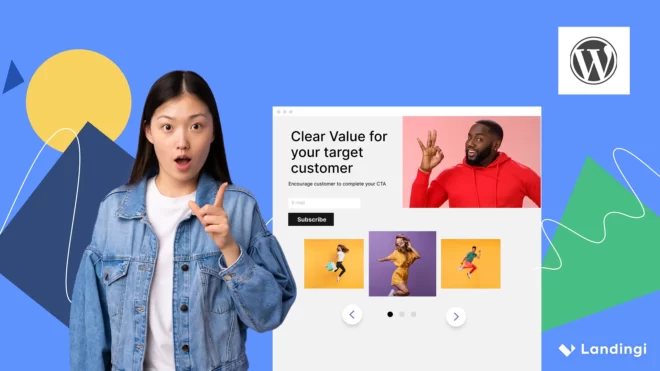What sets landing pages apart in the digital marketing realm? This article reveals the undeniable landing page benefits that can refine your strategy and escalate your conversion success, serving as a pivotal asset in your digital marketing endeavors.
With the ever-evolving digital landscape, landing pages have become more than just a static entry point; they are dynamic, interactive experiences that engage users and guide them toward making informed decisions.
Increasing the number of landing pages to 10-12 can boost lead generation by up to 55%, according to HubSpot study – it means that creating various good landing pages enables you to categorize your incoming traffic and design individualized landing pages for distinct audience segments.
By leveraging the power of well-designed landing pages, marketers can create a more personalized and impactful journey for their audience, ultimately leading to increased engagement and higher conversion rates.
From enhancing user engagement to providing actionable data, learn how these specialized pages could be the game-changers in your marketing toolkit, all without any filler or fluff. It’s up to you if you want to make use of this potential, but we bet after reading this article, you will be confident about the importance of landing pages.
Make your sections smartable and let go of mundane manual tasks with Smart Sections! An easy way to manage bulk changes.
Why Landing Pages Are Important?
Landing pages are important because they serve as the foundational elements in digital marketing strategies, where creating landing pages with a prime function to drive conversions and generate leads is essential. They do so by engaging visitors with a unique value proposition and offering tailored content like ebooks, online courses, or free trials. This targeted approach helps businesses better understand their audience’s preferences and generate insights for future campaigns.
But the magic of landing pages doesn’t stop at lead generation and customer insights.
They also play a critical role in improving a website’s search engine visibility.
When optimized correctly, landing pages incentivize visitors to engage further with the site, boosting SEO and improving the site’s visibility in search engine results.
The importance of landing pages in digital marketing can be summarized in 10 following points:
- Targeted conversion – landing pages are specifically designed to convert visitors into leads or customers, offering a streamlined path to conversion.
- Improved user experience – providing relevant and concise information enhances the user experience, directly influencing decision-making.
- Improved measurement and data insights – landing pages allow marketers to track user behavior, which is vital for understanding the effectiveness of marketing campaigns.
- Higher search engine rankings – optimized landing pages can improve search engine rankings, increasing visibility and attracting more traffic.
- Effective lead generation – they capture leads by offering valuable resources in exchange for contact information.
- Increased credibility – professionally designed landing pages build trust and credibility, which are essential for converting visitors into customers.
- A/B testing opportunities – marketers can test different elements on landing pages to determine what works best, optimizing their marketing strategies.
- Segmented messaging – they allow for targeted messaging, catering to specific audience segments, which improves engagement and relevance.
- Cost-effective marketing – by focusing on specific products or services, landing pages can be economical, yielding a high return on investment.
- Supports business goals – whether for email list building, sales, or event registration, landing pages support various business goals by providing a clear call to action.
Furthermore, landing pages also aid in brand recognition. Consistent branding elements, like logos and visual elements, help keep the brand memorable, even if visitors leave the page quickly.
Do I Need a Landing Page?
You need a landing page as your personalized multi-tool of online marketing – they are versatile, functional, and incredibly useful in driving conversions. Specific landing pages provide a follow-up to the promises made in your content, guiding the visitor closer to becoming a customer. They can lead to another page, like an e-commerce site, or be lead-generation based, offering items like ebooks or free trials in exchange for contact information.
But that’s not all. By focusing the visitor’s attention on completing the call to action, landing pages enhance conversion rates compared to a general homepage. They also allow businesses to target specific audiences, such as landing page visitors, and offer them something of value, increasing the likelihood of turning visitors into leads.
The data collected from landing pages can enhance marketing strategies and sales approaches, making them an indispensable tool for every marketer’s toolkit.
What Are the 7 Top Benefits of Landing Pages?
The top benefits list of landing pages starts at the moment when you realize they are not just simple web pages but powerful tools that can revolutionize your digital marketing strategy. They offer numerous benefits that go beyond lead generation and conversion optimization.
Let’s explore the 7 top benefits landing pages provide businesses:
- Increasing conversions,
- Enhancing user experience,
- Improving ad performance,
- Building brand identity,
- Simplifying campaign tracking,
- Encouraging social sharing,
- Facilitating A/B testing.
Now, examine each of these benefits in detail.
#1 Increasing Conversions
Firstly, landing pages are pivotal in boosting conversion rates because they focus on turning website visitors into leads or customers. Picture this: conversion rate optimization is the name of the game in digital marketing, and landing pages are the star players. They are designed with a singular focus on a specific campaign or offer, resulting in more precise and targeted messaging. This focus minimizes distractions and creates an environment conducive to increasing conversions.
Take a look at the example below:

This dedicated landing page is created to showcase the Heyday product and encourage web page visitors to sign up for a free trial. Technically, the landing page is beneficial in terms of increasing conversions, thanks to the following elements that keep a singular focus on the product presentation:
- clear layout without distraction elements,
- single, strong CTA,
- headlines referring to product functionalities,
- product animated visualization,
- short but informative product description.
Each element of this sample is designed to keep visitors focused on a product and encourage them to try it for free – convert into leads by leaving an e-mail address.
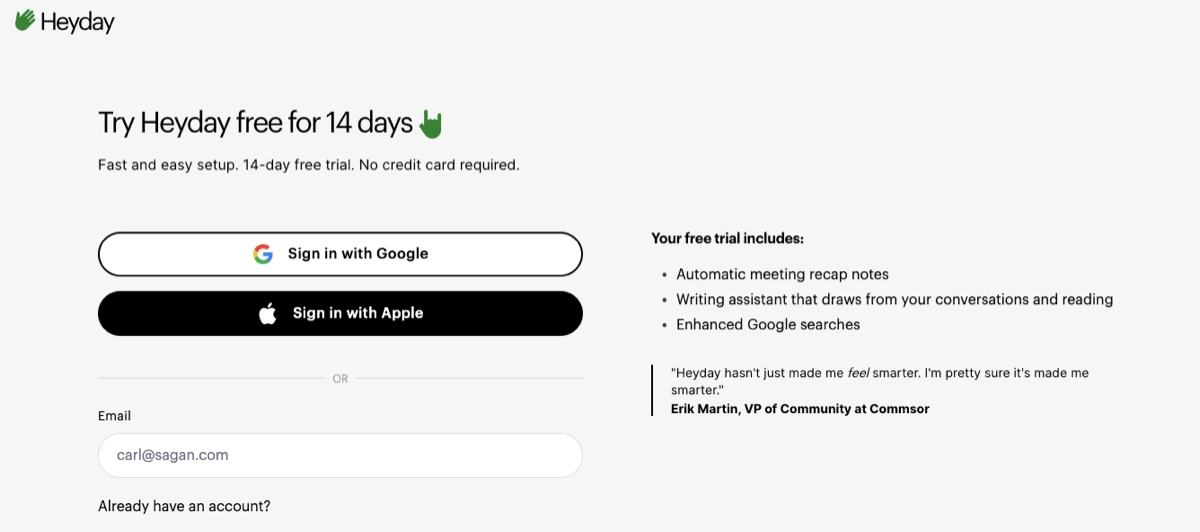
Moreover, the clarity of the message on a landing page, coupled with limited options for navigation, ensures that the visitor remains focused on the campaign’s primary goal. This focus is further enhanced by incorporating social proof like social media reviews and testimonials on a landing page. This validation increases trust and can lead to a higher conversion rate.
#2 Enhancing User Experience
Secondly, an optimized landing page enhances user experience by offering a focused and intuitive interface for various devices. By providing a tailored experience, they create a positive impression and encourage further engagement. This personalization helps build trust, fostering long-term relationships with users.
Take a look at the example below:
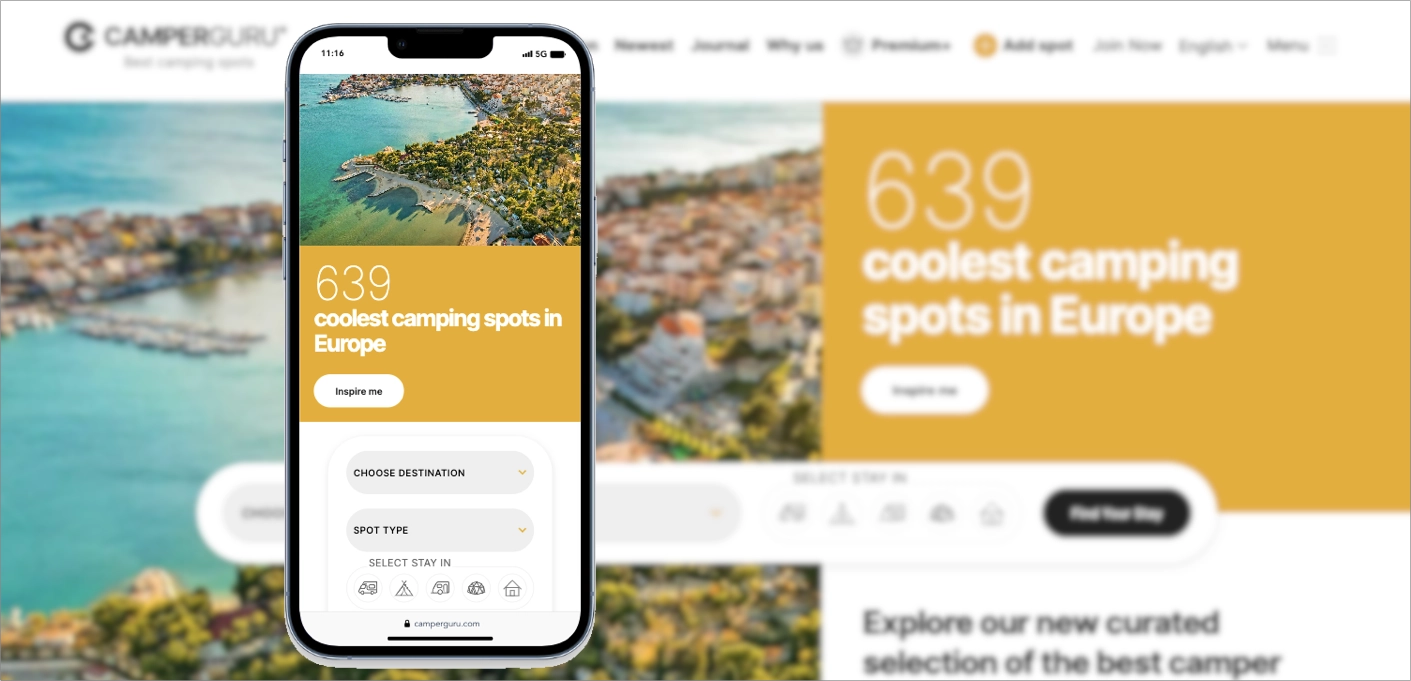
This landing page is well-optimized, delivering seamless navigation for desktop and mobile users, which is crucial in today’s multi-device world, where users expect a fluid experience across all platforms. The responsive design ensures that the page will maintain its aesthetic appeal and functionality if a visitor clicks through from a laptop, taps on a tablet, or scrolls on a smartphone.
Adaptability caters to user preferences and contributes to better search engine rankings, as mobile-friendliness is a key factor in SEO. Furthermore, intuitive navigation contributes to a positive user experience, significantly reducing bounce rates and increasing the likelihood of conversion.
Elements like customer reviews and social media posts on landing pages can significantly impact user experience, contributing to a successful customer journey. These components validate the product or service’s value, thereby increasing the trust factor and potentially leading to higher conversion rates.
Additionally, incorporating videos aligns with customer preferences for information consumption and can increase user trust and retention.
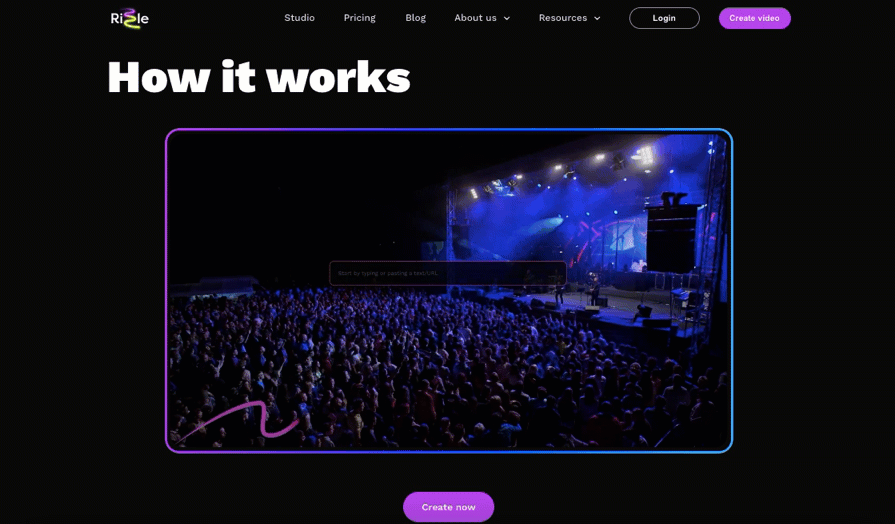
#3 Improving Ad Performance
Thirdly, landing pages can significantly improve ad performance by contributing to higher quality scores. By being relevant and offering targeted content, landing pages can reduce cost per click (CPC). Landing page relevance is established through carefully crafted content that aligns with the keywords and ad copy, resulting in a seamless experience for the user.
Take a look at the example below:

When landing pages closely match the expectations set by the ad, it signals to Google that the content is highly relevant to the searcher’s query, thus improving the quality score. A higher quality score can lead to better ad positions, giving your ads greater visibility and potentially increasing click-through rates (CTR).
This strategic alignment between ads and landing pages is a fundamental aspect of PPC campaign management that can significantly influence your digital advertising efforts’ overall success and efficiency.
Moreover, landing pages serve as a destination for ad traffic, enhancing user engagement and driving higher conversions. Google Ads even offers a Landing Page Report that provides insights into your landing page’s performance.
#4 Building Brand Identity
Fourthly, dedicated landing pages strengthen brand identity through consistent design and messaging. Consistent branding across landing pages can increase brand recognition and influence consumer spending. They act as a natural extension of digital advertising, creating a focused message and personalized experience that align with your brand strategy.
Moreover, personalized post-click landing pages help articulate the unique value proposition of a product to specific personas, reinforcing the brand’s core values and managing customer perceptions.
Take a look at the example below:

Landingi delivers hundreds of landing page templates that inspire users to craft individual designs by utilizing the user-friendly drag-and-drop editor.
But the essence of these templates is truly realized with the full brand visual identity, so each template has a Thank You page, which can appear after completing the call-to-action and filling out the form or making a purchase.

The benefits of personalized post-click landing pages include:
- Reinforcing the brand’s core values
- Building consumer trust
- Strengthening a brand’s identity
- Addressing pain points
- Including trust elements like professional design and quality content
By utilizing personalized post-click landing pages, brands can effectively communicate their value proposition and build trust with their target audience.
#5 Simplifying Campaign Tracking
Fifthly, landing pages simplify the tracking of marketing campaign performance. They are an invaluable tool for user behavior tracking and gathering essential data for further optimization. By focusing on a single call to action, landing pages simplify performance measurement, making tracking your marketing campaign’s success easier.
Using dedicated landing pages for marketing campaigns offers several benefits:
- Enhances accountability by providing actionable data on traffic and conversion rates
- Helps in the effective allocation of the marketing budget
- Allows for measurement of conversion metrics to determine campaign performance
- Identifies areas for communication adjustments to improve conversion rates
For such purposes, the choice of landing page builder is essential, as its side features can allow marketers to gather data on visitor behavior and preferences, enabling them to refine their marketing strategies and make data-driven decisions for higher converting leads. Landingi provides an innovative, built-in EventTracker tool that simplifies the process by providing insights right in the Landingi dashboard.
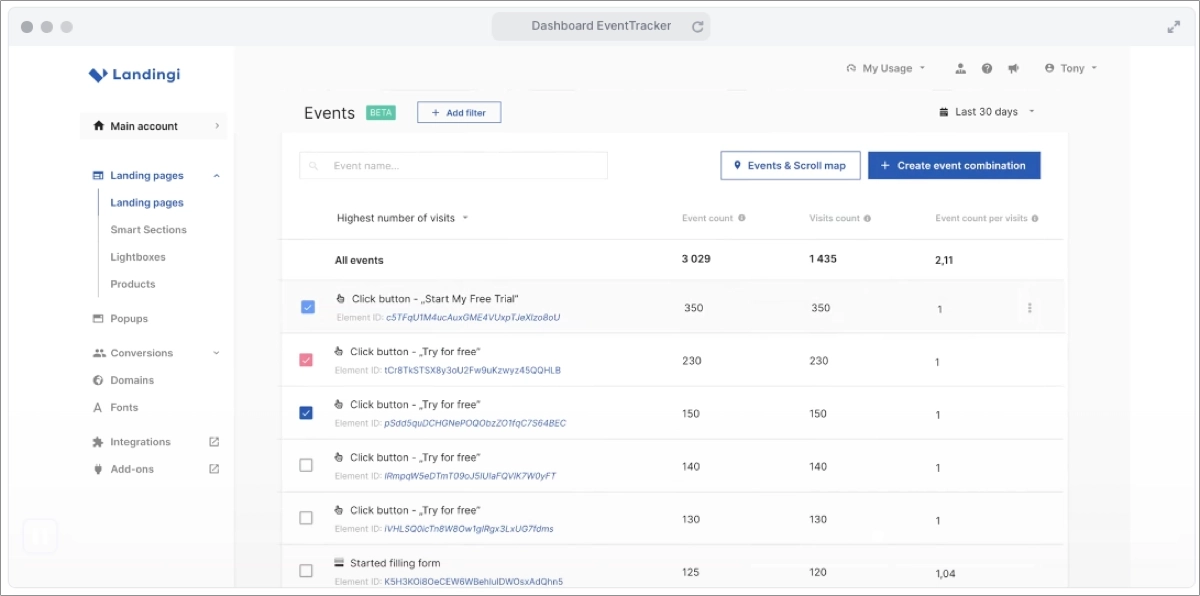
#6 Encouraging Social Sharing
Sixthly, landing pages encourage social sharing through integrated social media features. Social sharing is a powerful tool for increasing brand exposure, and landing pages are the perfect platform to encourage it. By integrating social media into landing pages, businesses can enhance trust with potential customers and improve the overall user experience.
Take a look at the example below:
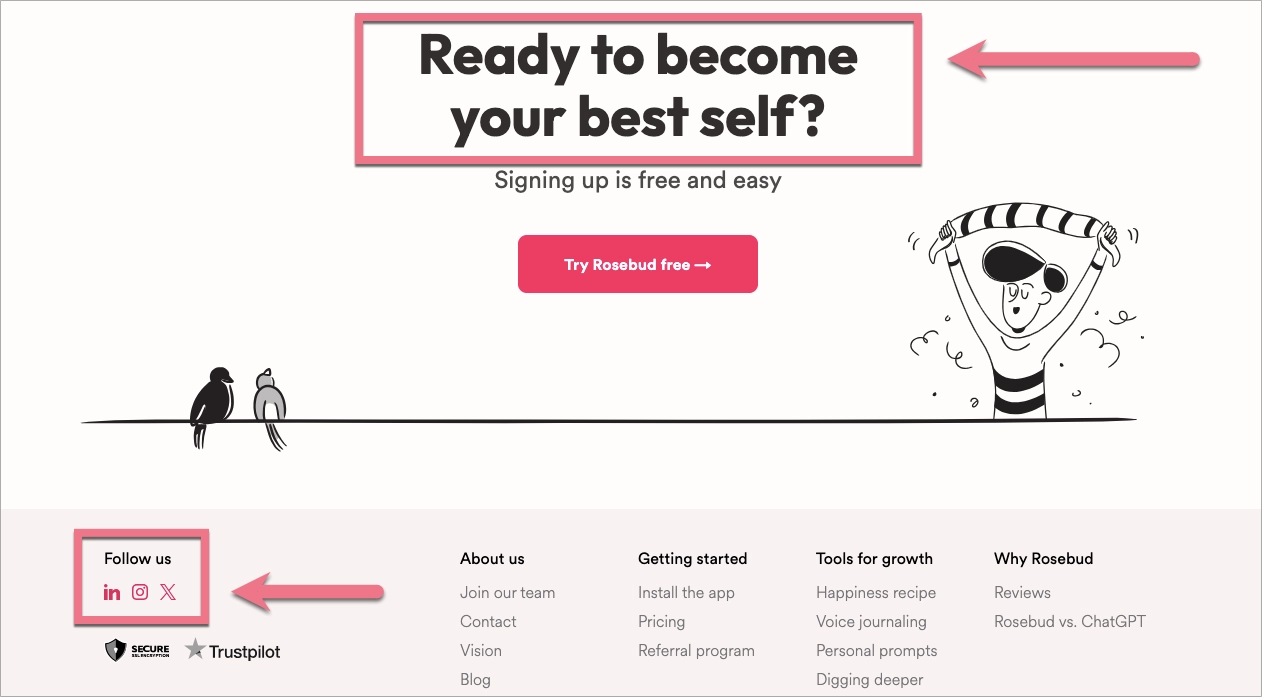
As in the example, providing social media buttons on landing pages encourages visitors to share the content with their networks, thus increasing brand exposure.
The headlines on landing pages play a crucial role in social sharing, as more than half of social shares are driven by headline readership on landing pages. To promote sharing, landing pages often include share links that visitors can easily use to distribute content among their audience.
#7 Facilitating A/B Testing
Lastly, landing pages facilitate A/B testing for ongoing optimization – a powerful tool for fine-tuning digital marketing efforts. By comparing different approaches, Through the process of A/B testing, businesses can experiment with various design elements and copywriting choices, identifying which combinations resonate best with their audience and lead to the desired outcomes. This methodical approach to testing enables companies to refine their landing pages with minimal risk, ensuring that they craft the most effective message and layout for their target demographic.
To execute A/B tests efficiently, selecting a tool that streamlines the process is crucial. Landingi simplifies A/B testing by allowing you to easily duplicate your existing landing page, apply variations, and track the performance directly from your dashboard. This enables you to collect critical data and determine the most effective version to apply to your original landing page.
As per Gitnux’s findings, while most marketers acknowledge the significance of SEO, a mere 65% actually put their strategies to the test, granting a competitive edge to those who engage in testing over those who refrain.
Moreover, the singular focus of many landing pages allows for frequent testing and optimization, enhancing their user friendliness and appeal. Changes and optimizations to landing pages through A/B testing can be made without impacting the main website or other stakeholders.
It’s essential to test various CTAs through A/B testing to see which versions achieve the highest conversion rates with the target audience.
Why Are Landing Pages Effective?
Landing pages are effective because they build credibility, showcase customer testimonials, and incorporate clear and compelling calls to action. They establish trust by featuring endorsements from satisfied clients. Including customer testimonials on landing pages adds authenticity to the brand experience and underscores the benefits of engaging with the company.
An effective landing page possesses key characteristics that enhance its ability to convert visitors into leads or customers, as the following 12 points:
- Clear and concise headline – it should instantly convey the value proposition and grab the visitor’s attention.
- Strong and clear CTA – it guides visitors toward the desired action, like signing up, purchasing, or downloading.
- Relevant and engaging content – it should resonate directly with the visitor’s preferences and challenges, captivating them enough to remain on the page.
- Simplified design – a streamlined, distraction-free design with an intuitive layout ensures visitors can effortlessly navigate and access the information they seek.
- Fast loading speed – pages that load quickly reduce bounce rates and improve user experience.
- Mobile optimization – as mobile device usage is high, ensuring your mobile-responsive design is crucial for engaging a broader audience.
- Use of visuals – high-quality images or videos can enhance the message and engage users more effectively.
- Trust signals – testimonials, customer reviews, and trust badges can increase credibility and trustworthiness.
- Minimal distractions – removing unnecessary links or information keeps the user focused on the primary message and CTA.
- Personalization – customizing the experience to align with the interests and needs of different user groups enhances the page’s relevance and conversion potential.
- Analytics and tracking – monitoring user interactions and measuring conversion success is crucial for assessing the page’s effectiveness and implementing data-driven improvements.
- A/B testing – testing different page versions allows for continuous improvement and optimization of the conversion rate.
An effective landing page is a blend of compelling content, user-friendly design, and strategic marketing elements, all working together to maximize conversions.
Get 111 Landing Page Examples—The Ultimate Guide for FREE
What Is the Most Important Purpose of a Landing Page?
The most important purpose of a landing page is general lead generation, contained in 4 pillars:
- Transforming site visitors into potential leads by collecting their data via a lead-capture form.
- Focusing on particular audience segments.
- Offering them enticing incentives in return for their contact details.
- Facilitating the generation of leads for companies.
A well-designed landing page is created to minimize distractions by hiding top and side navigation bars, reducing bounce rates, and increasing the chances of conversion. A landing page builder can help create these effective landing pages, which follow up with a ‘thank-you page’ or an email responder to confirm receipt of a lead’s information and provide further details or the offer itself on the web page.
The effectiveness of landing pages is largely attributed to their singular focus and minimal distractions, which help guide visitors toward completing a conversion goal.
How Do Landing Pages Improve Conversion Rates?
Landing pages improve conversion rates by designing and targeting specific campaigns or offers, resulting in more precise messaging, which is crucial for capturing potential leads.
Improving conversion rates by using landing pages contains the following:
- Using compelling and targeted copy on a landing page can address the visitor’s problem and demonstrate an understanding of their needs, increasing the likelihood of conversion.
- Including trust signals like client testimonials, awards, or certifications on a landing page can enhance credibility and encourage conversions.
- Simplifying the landing page by removing distractions and unnecessary navigation can help visitors focus on the conversion goal.
- Also, a strong and clear call to action on a landing page is crucial for directing visitors on what to do next, which can lead to higher conversion rates.
Can Landing Pages Significantly Impact Lead Generation Efforts?
Landing pages significantly impact lead generation efforts, as they are the start of the conversion funnel where prospective customers enter their information. Lead generation landing pages are designed to capture contact information and turn anonymous visitors into leads, which can be nurtured with targeted marketing communications.
The 3 reasons why landing pages are crucial for lead generation include the following:
- Establishing clear objectives for marketing initiatives
- Enhancing tailored communications for individual customer marketing
- Gaining deeper business insights by analyzing visitor interactions
Landing page forms are instrumental in beginning a dialogue with prospective customers, fostering this emerging relationship with personalized communication, and steering them through the sales funnel toward finalizing a purchase.
What Are the Benefits of Creating a Content-rich Landing Page?
Content-rich landing pages provide a highly engaging brand experience by acting as interactive web pages. Landing pages can be fully customized with a brand’s logo, images, and colors to create a mobile-first webpage without the need for coding skills.
The main benefits of content-rich landing pages are the following:
- Boosted visitors’ engagement – the key element of driving sales or generating leads is visitors’ interest in your offer, which builds well-matched content.
- Building memorable brand identity – landing pages can be customized with a brand’s visual elements, creating a consistent, strong brand identity.
- Enhanced analytics – landing pages offer insights into user behavior, enabling data-driven optimization.
- Ensuring mobile responsiveness – content-rich landing pages offer an uninterrupted user experience on any device.
- High user retention – including multimedia elements like images, videos, and infographics can boost user retention.
- Improved SEO – providing valuable content that satisfies user search intent helps drive organic search traffic.
- Providing marketing experimentation opportunities – to explore various content strategies and assess their impact on audience engagement and the success rate of conversions.
How Do Landing Pages Contribute to a Successful Sales Funnel?
Landing pages play a significant role in shaping a successful sales funnel by serving as a crucial touchpoint and acting as a bridge between the initial advertisement or content that captured the visitor’s attention and the point of conversion. A well-crafted landing page is focused on a single conversion goal, and its simplistic design directs visitors toward taking action, such as making a purchase or signing up for an email list.
Landing pages contribute to a successful sales funnel by the following:
- Lowering customer acquisition costs – by providing a clear and distraction-free path to conversion, which increases the conversion rate and efficiency of the sales funnel.
- Facilitating a specific action or conversion – by leading visitors to the next step in the customer journey and converting them into customers.
- Allowing for data collection – by gaining visitor information through forms, which is essential for lead generation and subsequent marketing efforts to nurture leads down the sales funnel.
Do Landing Pages Improve SEO?
Landing pages can significantly impact SEO strategy, as effective landing page optimization attracts organic traffic and the right potential customers. An SEO landing page aims to rank well in search results and drive conversions or leads by focusing on specific, targeted keywords and search intent.
The page’s design, content, imagery, and headers are guided by the search intent, emphasizing the importance of meeting user expectations to prevent confusion and potential bounce rates.
Landing pages optimized for search engine optimization (SEO) have the potential to attract organic search traffic, providing a stream of targeted visitors independently of paid advertising methods.
What Role Do Landing Pages Play in Search Engine Optimization (SEO)?
Landing pages play a vital role in SEO by the following:
- Targeting specific keywords and meeting search intent.
- Increasing search engine visibility.
- Driving targeted traffic.
- Attracting people interested in the topic, product, or service offered.
- Generating more leads and conversions.
Using well-researched keywords on a landing page helps achieve these goals.
The search intent dictates the layout, textual content, visual elements, and headings of the page, making it crucial to deliver what the user expects to see to avoid confusion and potential bounce. The URL of a landing page communicates the content and site structure to both users and search engines, contributing to a better understanding of the page’s context. SEO-friendly landing pages can earn organic traffic from search engines, serving as a source of targeted visitors without relying on paid methods.
What Are the Main Limitations of Landing Pages?
Despite their numerous benefits, there are a few limitations of landing pages, i.e., a significant obstacle in crafting unique content for landing pages lies in the inflexibility of templates provided by Email Service Providers (ESPs) and Marketing Automation Platforms (MAPs). This rigidity can restrict personalization options, posing challenges in effectively communicating a brand’s distinct message. Moreover, attempts to modify templates in ESPs/MAPs frequently result in disrupted layouts or non-functional elements, making even minor adjustments a source of frustration.
Landing pages may encounter challenges such as the following:
- Limited organic reach due to the competition and complexity of Google’s SEO and algorithms, which makes visibility and traffic generation increasingly challenging
- The absence of content, audience, and authority can leave a newly created or underutilized domain at a disadvantage
- The lack of necessary links and social media shares to gain traction hampers the spread of content through organic channels.
Still, you can continuously optimize your landing page to achieve better results by using proper tools for analytics, running A/B tests, and implementing changes that boost the page’s efficiency.
Conclusion
Landing pages are an indispensable tool in digital marketing, driving conversions, generating leads, and providing valuable insights into audience preferences. They offer numerous benefits, including:
- boosting conversion rates,
- enhancing user experience,
- improving ad performance,
- and strengthening brand identity.
Despite their limitations, the importance of landing pages in a successful digital marketing strategy cannot be overstated. They are the cornerstone of lead generation and conversion optimization strategies, playing a vital role in the architecture of any effective sales funnel.
If you want to succeed in the digital marketing world, there is only one advice – use well-crafted landing pages. Start with the best toolkit in the market delivered by Landingi – a multifunctional platform for creating high-converting landing pages, with features allowing for form creation, A/B testing, user behavior tracking, and much more. Try now – it’s free!








